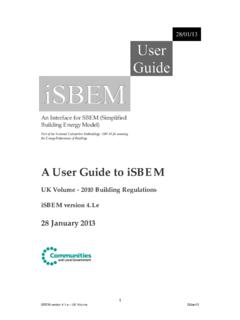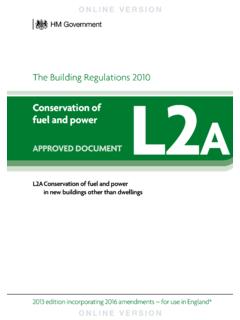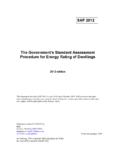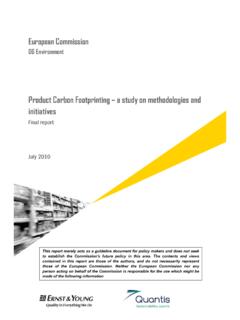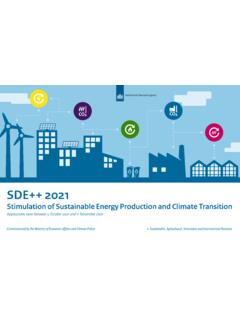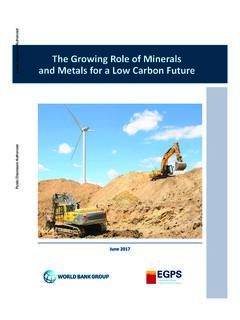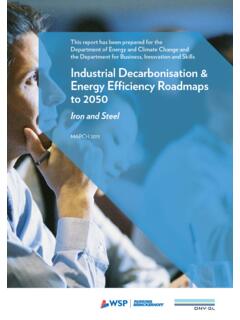Transcription of National Calculation Methodology (NCM) modelling guide ...
1 National Calculation Methodology (NCM) modelling guide (for buildings other than dwellings in England*) 2013 Edition November 2017 NCM modelling guide for buildings other than dwellings in England Page | 2 Main Changes in the 2013 Edition This NCM modelling guide comes into force on 6 April 2014 in support of the 2013 Edition of the Approved Document L2A: Conservation of fuel and power in new building other than dwellings. The main changes in the technical requirements of software since the issue of the previous NCM modelling guide are as follows: 1. New specifications of the Notional building for the 2013 edition, which are used to determine the carbon dioxide (CO2) target, have been defined to deliver a 9% CO2 savings across the new non-domestic building mix relative to Part L 2010.
2 2. The side-lit class of zones in the Notional building has been split into those with and without artificial cooling in place in order to widen the set of zones classes based on their access to daylight: unlit, side-lit (heated only), side-lit (heated and cooled), and top-lit. 3. The Notional building s air permeability has been further sub-divided by size. 4. The 2013 target emission rate is the 2013 Notional building emission rate ( , no additional improvement factors). If the actual building is constructed entirely to the notional building specifications, it will meet the target emission rate and the limiting values for individual fabric elements and building services.
3 Developers are, however, free to vary the specifications, provided the target emission rate is achieved or bettered. 5. A new set of fuel emission factors and primary energy factors for non-domestic buildings is provided in this document. 6. November 2015: Revised policy regarding software version to be used for producing EPCs. Addition of some further guidance and clarifications, for , regarding flags in the NCM Activity Database. 7. October 2016: Revised thermal capacity for the Notional building s roofs and walls. Guidance on reporting luminous efficacy. 8. November 2017: Update inference data of default luminous efficacy values for LEDs, addition of auxiliary energy for heating systems with integral fans, and revised minimum threshold of CO2 emission factor for district heating in the Notional building.
4 * This NCM modelling guide gives guidance for compliance with the Building Regulations for England. It also applies to new buildings other than dwellings that are excepted energy buildings in Wales as defined in the Welsh Ministers (Transfer of Functions) ( ) Order 2009 and to new buildings other than dwellings that are buildings of statutory undertakers and of the Crown or Crown authorities in both England and Wales. NCM modelling guide for buildings other than dwellings in England Page | 3 CONTENTS Introduction ..5 Notice of approval ..5 Version policy ..6 Choosing a software tool ..7 SBEM constraints ..7 Compliance with Building Regulations.
5 9 The Notional Building ..9 Activity glazing class .. 10 Building fabric .. 10 Areas of windows, doors, and roof-lights .. 13 HVAC system .. 14 Auxiliary energy .. 19 Lighting power 21 The target emission rate (TER) .. 22 The Actual 23 Building fabric .. 23 Lighting .. 24 Auxiliary energy .. 26 Demand control of ventilation .. 29 Shell & core .. 30 Modular and portable buildings .. 31 Criterion 3: Limiting solar 32 Appendix A Construction details for 2013 Notional building .. 36 Appendix B The Reference 41 Building fabric .. 41 Areas of windows, doors, and roof-lights .. 43 HVAC system .. 45 Lighting power 47 Calculating the asset rating.
6 47 Constructing the rating scale .. 48 Reference values and benchmarks .. 48 Technical information .. 49 Appendix C - Input data to approved tools .. 50 Defining internal gains and environmental conditions .. 50 Constructions .. 51 NCM modelling guide for buildings other than dwellings in England Page | 4 Low and zero carbon systems .. 52 Weather location .. 52 Zoning rules .. 53 Zone types .. 53 Combining adjoining thermal zones .. 54 Fuel emission and primary energy factors .. 54 HVAC .. 55 Lighting .. 55 Adjustment factors .. 55 Measurement and other conventions .. 56 Appendix D EPBD Recast .. 57 Primary energy consumption .. 57 Alternative energy systems.
7 57 NCM modelling guide for buildings other than dwellings in England Page | 5 INTRODUCTION 1. This document, which takes effect on 6 April 2014, gives guidance on the use of the government s Simplified Building Energy Model (SBEM) and other approved software tools comprising the National Calculation Methodology (NCM) when: a. Demonstrating compliance with the carbon dioxide (CO2) emission requirements of the Building Regulations1 for England in respect of buildings other than dwellings. b. Calculating the asset ratings as part of preparing Energy Performance Certificates (EPCs) for buildings other than dwellings. 2. It is expected that separate guidance will be produced by accreditation bodies regarding the forward transmission of the results of these calculations for the purposes of lodgement on the National Register and the formal issue of EPCs and Recommendation Reports to building owners.
8 3. It is expected that separate guidance will be published for the application of the Methodology when using approved tools to demonstrate compliance with the applicable regulations in Wales, Scotland, and Northern Ireland. 4. This document is under continuous review and will be updated as and when the need for additional clarification is identified. This regular updating will help improve the consistency of application of the various tools to the Building Regulations compliance and energy certification processes. Notice of approval 5. The Notice of Approval sets out: a. The Methodology approved by the Secretary of State for calculating the energy performance of buildings (including methods for calculating the Asset Rating and Operational Rating of buildings); and b.
9 The approved ways of expressing the energy performance of buildings. 6. Associated with the Notice of Approval are tables showing when individual software tools have been approved. This document gives guidance on how those approved software tools should be used: a. For demonstrating compliance with regulation 26 of the Building Regulations; and b. For calculating the Asset Rating as part of the production of an EPC. 7. To be approved, the software tool must satisfy the criteria as published by the Department of Communities and Local Government (DCLG). These requirements are updated from time to time and cover a number of generic issues as follows: a.
10 The software tool has to demonstrate that the calculations are technically robust, and that they cover a necessary minimum set of energy flows. 1 Building Regulations 2010 (SI 2010/2214), as amended. NCM modelling guide for buildings other than dwellings in England Page | 6 b. The software tool has to demonstrate that it follows the procedures for compliance and certification as defined in this document, including the use of the NCM databases, the definitions of Notional and Reference buildings, and other issues as defined from time to time. c. The software tool has to demonstrate that it reports a minimum set of output parameters, and that these parameters can be passed appropriately to standard modules for: i.

